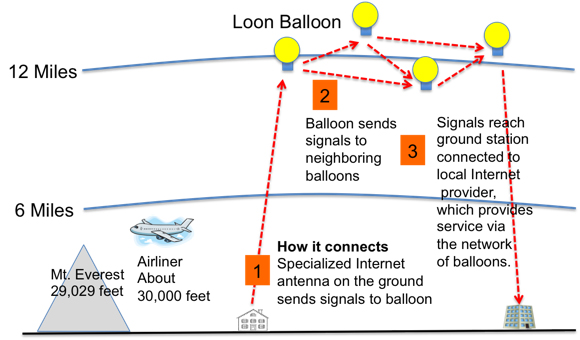Science & Technology
Internet Through High Altitude Balloons
- 20 Jul 2021
- 4 min read
Why in News
Recently, the US has planned to transmit the Internet to the people in Cuba via high-altitude balloons when their government has blocked access.
- There is an ongoing protest in Cuba against long standing restrictions on rights, scarcity of food and medicines, and the government’s poor response to the Covid-19 pandemic.
Key Points
- High Altitude Balloons for Internet:
- They are commonly known as Loon Balloons as the first High Altitude Balloon for providing internet was used under Project Loon.
- They are made of the commonplace plastic polyethylene and are the size of a tennis court.
- They are powered by solar panels and controlled by software on the ground.
- While up in the air, they act as floating cell towers, transmitting internet signals to ground stations and personal devices.
- They float 60,000 to 75,000 feet, above the Earth, well above commercial jetliner routes.
- They last for well over 100 days in the stratosphere before being returned to earth.
- Each balloon can serve thousands of people. But they had to be replaced every five months or so because of the harsh conditions in the stratosphere. And the balloons can be difficult to control.
- Requirements:
- Network:
- Beyond the balloons themselves, it needed network integration with a telecom to provide service and some equipment on the ground in the region.
- Permission:
- It also needs permission from local regulators.
- Network:
- Significance:
- Cheap:
- By allowing phone companies to expand their coverage where needed, the balloons are intended to offer countries a cheaper option than laying cables or building cell towers.
- Access to Remote Areas:
- They are able to bring Internet access to remote and rural areas poorly served by existing provisions, and to improve communication during natural disasters to affected regions.
- Cheap:
- Challenges:
- Need Unused Band:
- It would need an unused band of spectrum, or radio frequencies, to transmit a connection, and spectrum use is typically controlled by national governments.
- Anyone trying this would have to find a free block of spectrum that wouldn’t be interfered with.
- Uneconomical:
- Balloon- or drone-powered networks aren’t likely to be economical over the long term.
- Operational Challenges:
- Developing algorithms to appropriately map balloon positions, determining a good strategy to deal with unpleasant weather and addressing the concern of relying on the non-renewable resources are among other challenges.
- Need Unused Band:
Project Loon
- It was started in 2011 by Alphabet, the parent company of Google. It was a network of stratospheric balloons designed to bring Internet connectivity to rural and remote areas.
- It shut down that project in January 2020 as it wasn’t commercially viable.
- Prior to the shutdown, Loon balloons had been providing service in mountainous areas in Kenya through a partnership with a local telecom.
- The service also helped provide wireless communications in Puerto Rico in the aftermath of Hurricane Maria.







